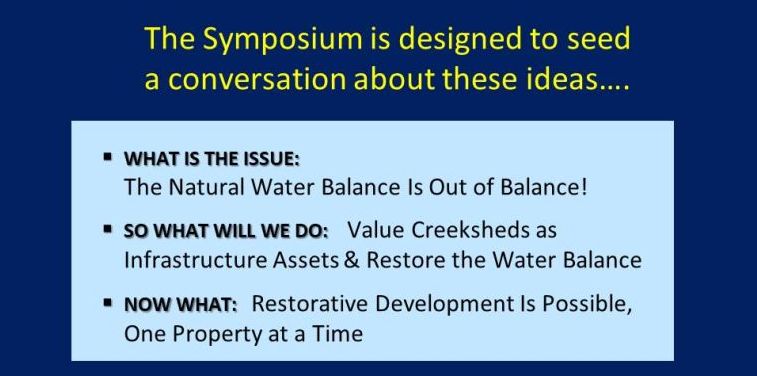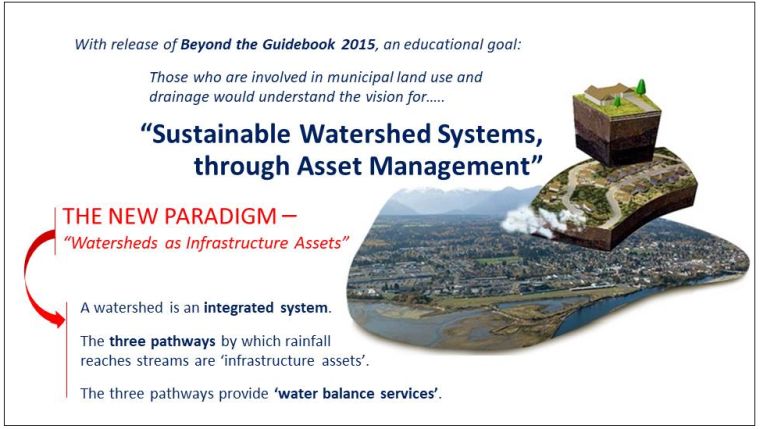KEYNOTE PRESENTATION AT NANAIMO WATER SYMPOSIUM: “Sponge Communities: A Water-Resilient Future Despite Floods & Droughts?” – Kim Stephens, Partnership for Water Sustainability in British Columbia
Note to Readers:
At the Nanaimo Water Symposium in April 2018, participants learn about watershed stewardship, the water balance and restorative development. In his co-keynote presentation, Kim Stephens explains the call to action for Sustainable Watershed Systems through Asset Management.

Restore the capacity of the urban landscape to absorb water and release it naturally
“Recent water-centric developments in China and Berlin have caught the attention of the Partnership for Water Sustainability in British Columbia,” states Kim Stephens, Executive Director. “Initiatives in China and Berlin provide reason for optimism. Also, it is reassuring that they too are on a journey where the destination is a water resilient future.
 “Consider that, in 2013, President Xi Jinping injected a new term into the global urban design vocabulary when he proclaimed that cities should “act like sponges” and launched China’s Sponge City program. And then, in August 2017, the Senate of Berlin released its Sponge City Strategy.
“Consider that, in 2013, President Xi Jinping injected a new term into the global urban design vocabulary when he proclaimed that cities should “act like sponges” and launched China’s Sponge City program. And then, in August 2017, the Senate of Berlin released its Sponge City Strategy.
“The common guiding philosophy for both? Mimic nature, restore the water balance, adapt to a changing climate. The ‘sponge city’ imagery resonates. People intuitively get it.”
“The ‘sponge city’ metaphor is powerful and inspirational. As such, China and Berlin are demonstrating that when there is a will, there is a way. Still, take a moment to reflect upon their drivers for action – floods and droughts! They have learned the hard way that what happens on the land matters. And now, the ‘new normal’ of frequently recurring extremes has forced them to tackle the consequences of not respecting the water cycle.

Rethinking our relationship with nature is necessary because…
“The warming of the planet’s atmosphere is causing water to move more quickly and disruptively through the global water cycle. Flood, drought, fire, wind and cold – extreme events are becoming the norm. Instabilities in the water cycle are increasingly apparent,” explains Kim Stephens.
“All one need do is reflect on what British Columbia has experienced in 2015, 2016 and 2017. Impacts are magnified by human interventions. We have arrived at a fork in the road.
“The situation calls for a whole-systems approach to managing the water balance distribution where people live. The risks are too high, and the margins for error too small, to view water and watersheds only through narrow technical lenses. Adapting to changes in the water cycle and restoring the water balance starts with rethinking our relationship with nature.”
The Challenge
“Opportunities for land use and infrastructure servicing practitioners to make a difference are at the time of development and redevelopment,” emphasizes Kim Stephens. “To those folks we say: share and learn from those who are leading change; design with nature; ‘get it right’ at the front-end of the project; build-in ‘water resilience’; create a lasting legacy.
“Many land and infrastructure professionals in this province do know in principle what they ought to do. However, there is still a gap between UNDERSTANDING and IMPLEMENTATION. This results in a capacity-building challenge: on the one hand, we can provide practitioners with water balance tools and resources; it is another matter for those folks to apply the tools and resources.
Mission Possible
“Yes, British Columbia is progressing,” continues Kim Stephens. “Yet communities could do so much more if they would capitalize on rather than miss opportunities. Apply the tools. Do what is right. Learn from experience. Adapt. Pass the baton.
“The Partnership spotlight is on how to ‘bridge the gap’ between talk and action. As champions for the Whole-System, Water Balance Approach, we are developing tools and resources for use by local governments.”
To Learn More:
Download the 7th in the Watershed Case Profile Series, titled a Water Balance Approach on Vancouver Island.

What / So What / Now What
“My keynote presentation for the Nanaimo Water Symposium references and foreshadows what comes later in the program,” states Kim Stephens. “The breakdown of the audience is about 75% stewardship sector and 25% local government. Thus, the storyline is structured in three part to engage, inform and educate everyone equally so that they have a shared understanding of what matters most.
“An over-arching message is that adapting to climate change requires transformation in how we value nature and service land. And an informed stewardship sector can be a catalyst for action.
“The What-So What-Now What way of thinking is a useful mind-map to focus the audience and lead them through the logic of what needs to be done, and why.”

Moving towards a Water-Resilient Future….
“The capacity-building program for “Sustainable Watershed Systems, through Asset Management” is aligned with the vision for Asset Management for Sustainable Service Delivery: A BC Framework,” states Kim Stephens. “The BC Framework sets a strategic direction that refocuses business processes on outcomes that reduce life-cycle costs and risks.
“Funded by the governments of Canada and BC, the capacity-building program is designed to inform and educate local governments about the whole-system, water balance approach. A guiding principle is that regulatory objectives linked to the BC Framework would be the catalyst to transform drainage engineering practice at the site scale.
“Asset management has traditionally been about hard engineered assets such as waterlines, sanitary and storm sewers, and roads. Yet, watershed systems are also ‘infrastructure assets’. More specifically, trees, soil, green spaces and Water Balance pathways contribute to a municipal service function.
“These assets provide hydrologic integrity for a healthy watershed system. This is a driver for protecting and managing nature’s services in the same way that engineered assets (and the services they provide) are managed.”
Asset Management Continuum for Sustainable Service Delivery
“We needed a way to conceptualize this process diagrammatically, and thus communicate what the journey by a local government to a Water-Resilient Future would look like. This led to the concept of a continuum of steps:
- Step One – embrace the BC Framework
- Step Two – implement Sustainable Service Delivery
- Step Three – apply the Ecological Accounting Process
“The goal is to build local government capacity to transition to Step Three. The outcome would be Sustainable Watershed Systems.
“In Step Three, the principal focus of the Ecological Accounting Process is on the investment of resources already made by many stakeholders, as well as their aspirations concerning the management (prevention of degradation to and work on enhancement) of ecological services in the creekshed.”


